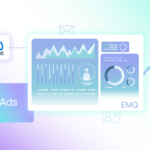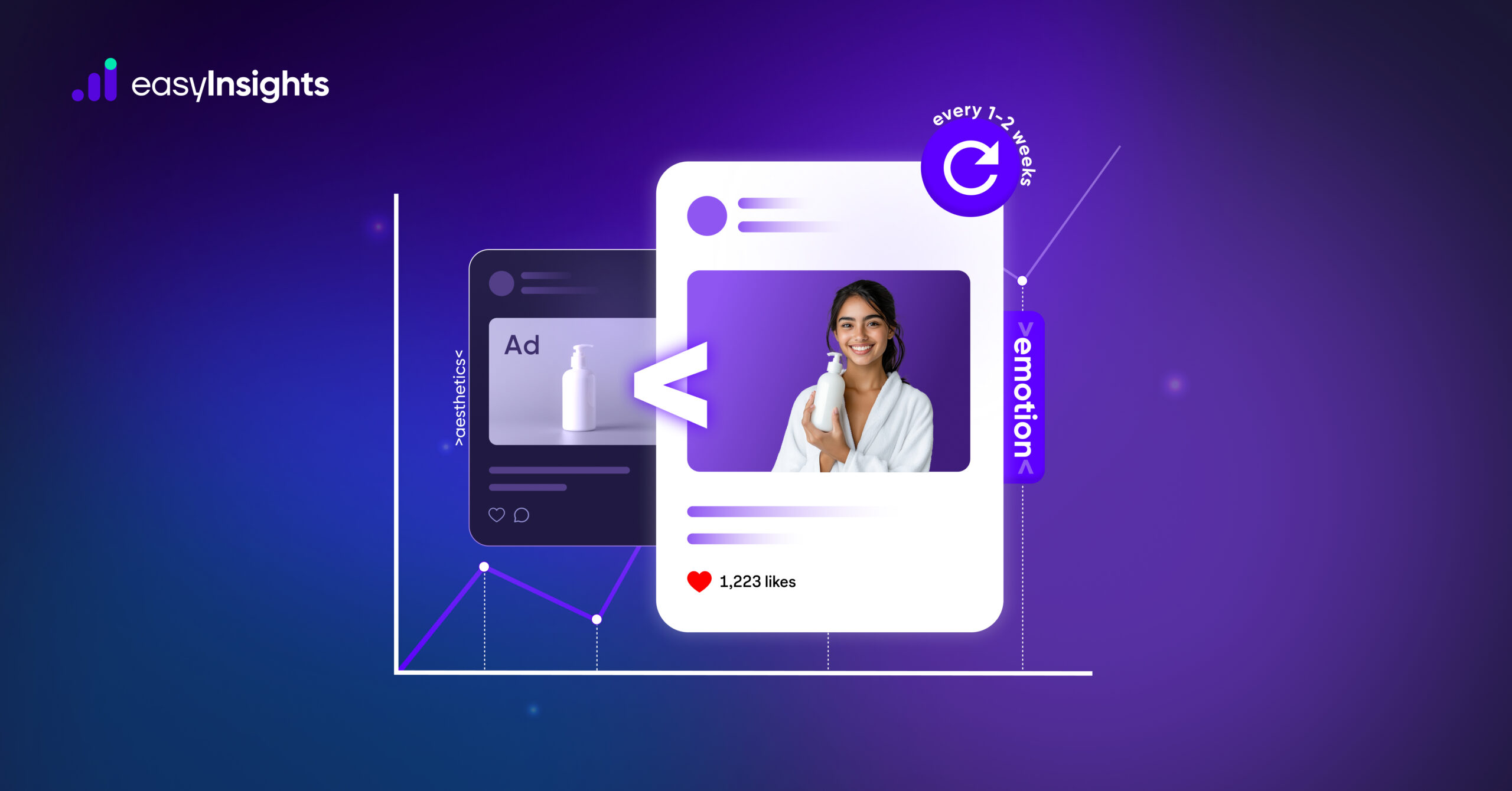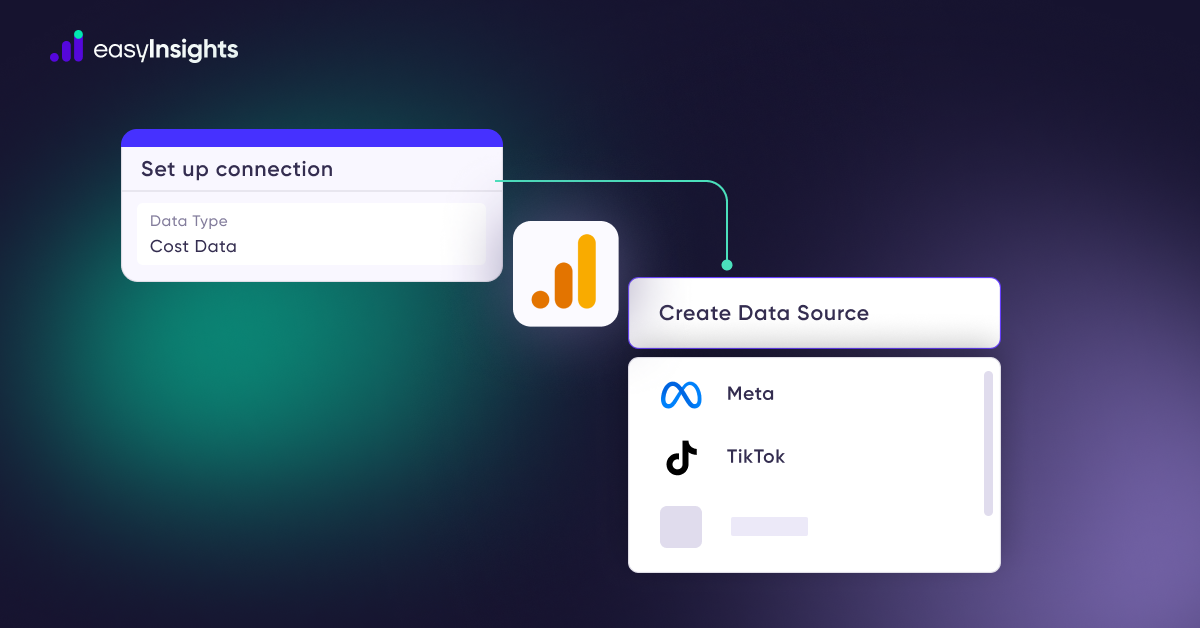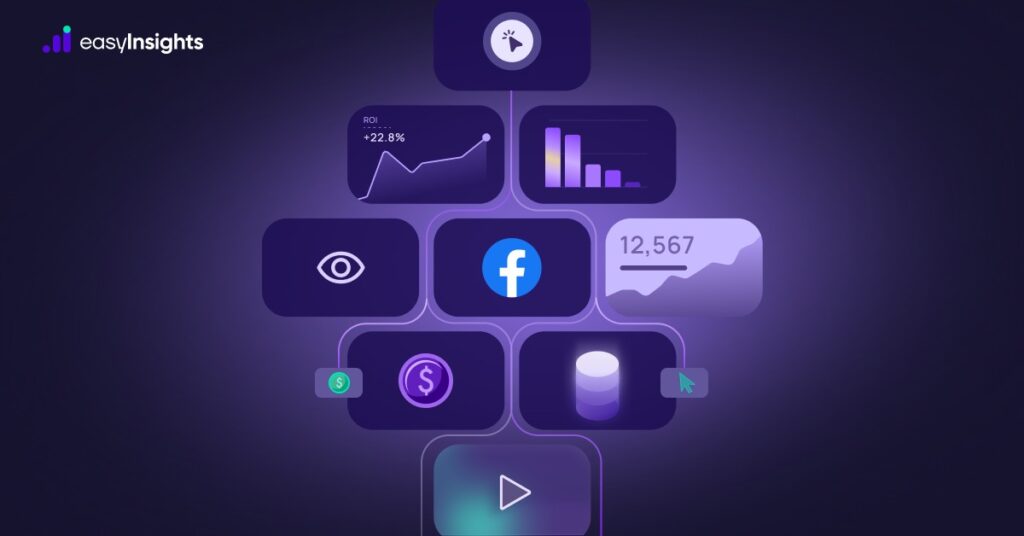
Facebook Ad metrics are like a report card for your ads. They show how well your ads are doing on Facebook, Facebook stands as the most popular social media platform worldwide, with 3.07 billion monthly active users, the highest among all social media platforms. By looking at these numbers, advertisers can see if their ads reach the right people, get good engagement, and make money.
This guide will help you focus on the most important numbers to track so you can improve your ads and get better results. We’ll break down the 10 most important metrics to track for your Facebook ads and explain how to create clear, easy-to-read reports. By the end, you’ll know which numbers to focus on and how to save time with ready-made templates for your reports.
Jump ahead to:
Key Facebook Ad Metrics you should Track
Metrics are grouped into three main categories that you can find in your Facebook Ads account:
- Performance Metrics
These tell you how well your ads are achieving their goals, like driving clicks, sales, or leads. - Delivery Metrics
These show how often and where your ads are being seen, and how many people they’re reaching. - Engagement Metrics
These measure how people are interacting with your ads, like liking, commenting, or sharing.
Performance Metrics
When running Facebook ads, the most important question is: Are your ads achieving what you set out to do, and how much is it costing?
What Are “Results”?
Results are the total number of times your ad achieved its goal. This can vary depending on the type of campaign you’re running and the brand’s objective you’ve set. For example:
- If your goal is sales, results will show the number of purchases made on your website.
- If you’re aiming for leads, results will track how many people signed up or provided their contact details.
- For brand awareness campaigns, results might measure how many people saw your ad (impressions) or visited your website (traffic).
Here are a few examples of what “results” might look like for different campaigns:
- Website Purchases: The total number of items bought through your website.
- Leads: The number of new potential customers who shared their contact info on your website.
- Form Leads: Facebook’s “Lead Ads” allow users to fill out forms directly on the app. This metric shows how many people submitted their info using these forms.
- Custom Conversions: These are specific actions you can track on your website using the Facebook Pixel, like eBook downloads, webinar signups, or free trial registrations.
Focusing on results allows you to see whether your ads are helping you achieve your brand goals and where you might need to adjust your strategy.
1. Cost per Acquisition (CPA)
Cost per acquisition (CPA) is one of the most important metrics in Facebook advertising because it calculates the average cost of each successful result or action your campaign is designed to achieve. A “result” can vary depending on the objective of your ad campaign as explained above.
Why is CPA Important?
CPA gives you a clear picture of how cost-effective your campaign is. A lower CPA means you’re spending less money to achieve each result, which indicates higher efficiency. It’s a critical metric for:
- Budget Optimization: Helps you identify which ads or campaigns are delivering the best results for the lowest cost.
- Evaluating ROI: By comparing CPA to the revenue generated per result, you can determine if your campaign is profitable.
- Campaign Comparison: This allows you to compare the performance of different campaigns, ad sets, or even industries.
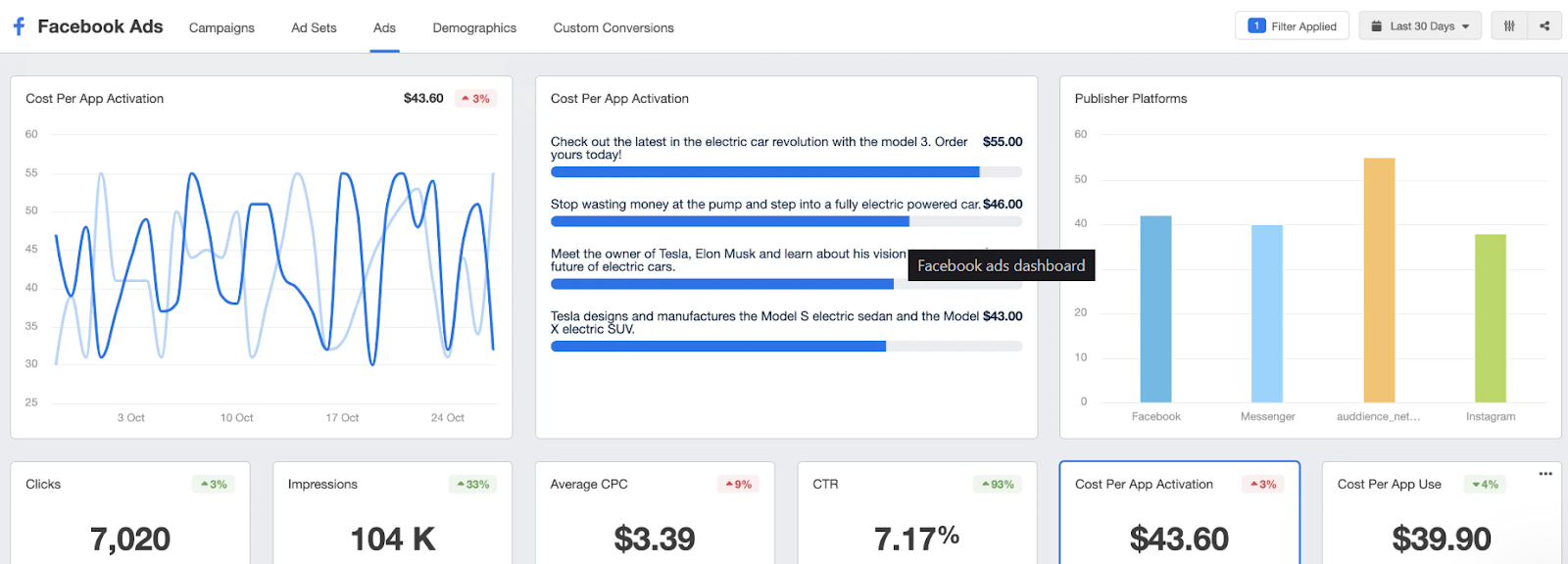
Additional Reading: How to Use Marketing Attribution and Optimize Your ROI
2. Conversion Rate
The Conversion Rate on other platforms measures the effectiveness of your Facebook ads in achieving the desired action or result. It shows the percentage of people who saw your ad and then completed the specific action your campaign is designed to achieve.
Why is Conversion Rate Important?
Result Rate is a key indicator of how well your ad resonates with your audience and drives the desired action. Here’s why it matters:
- Measures Effectiveness: A high Result Rate means your ad is performing well and driving results efficiently.
- Compares Campaigns: It allows you to compare the performance of different campaigns or ad sets to see which ones are more effective.
- Improves ROI: A better Result Rate means you’re getting more results for the same number of impressions, which can lead to a higher return on investment (ROI).
3. Spend: Keeping Track of Your Ad Budget
Spend is a simple yet essential metric in Facebook advertising. It tells you the total amount of money you’ve spent on your ads over a specific period. While it might seem straightforward, monitoring spend is critical to ensuring you’re staying within your budget and making the most out of every dollar you invest in your campaigns.
For example: If your daily budget is $50 and you’ve run a campaign for 10 days, your total spend would be $500.
Why is Spend Important?
Spending is more than just a number it’s a reflection of how well your campaign is being managed. Here’s why tracking it is so important:
- Budget Control: It helps you ensure you’re not overspending and staying within the limits.
- Performance Evaluation: Spend alone doesn’t tell you if your campaign is successful. You need to pair it with other metrics like CPA and ROAS to determine if your investment is paying off.
- Avoiding Wasted Money: Ensure you’re not overspending on underperforming ads or showing ads to the same audience too often (which can lead to ad fatigue).
4. ROAS (Return on Ad Spend): Measuring Your Ad Success
ROAS is a marketing metric that calculates how much revenue your company earns for every dollar spent on advertising. A profitable ROAS should always be greater than one, anything lower means the brand is losing money on ads.
However, tracking ROAS can be challenging for some businesses. For example, a B2B construction company running ads for lead generation may not see immediate revenue from those leads. In such cases, assigning a value to each website conversion helps estimate ROAS effectively.
Why is ROAS Important?
ROAS is one of the most important metrics for evaluating the success of your ad campaigns because it directly ties your ad spend to your business revenue. Here’s why it matters:
- Measures Profitability: ROAS tells you if your ads are making money or wasting it.
- Helps Optimize Campaigns: By comparing ROAS across different campaigns, you can identify which ones are performing well and which need improvement.
- Informs Budget Decisions: A high ROAS might encourage you to increase your budget for a successful campaign, while a low ROAS could signal the need to pause or adjust a campaign.
Additional Reading: Facebook Ads: Increasing ROAS by 20%
Delivery Metrics
Are your ads reaching your audience effectively? These Facebook Ads metrics help you understand how well your campaigns are performing in terms of visibility and the cost of getting your ads in front of people.
5. Reach
The number of unique users who saw your ad. It helps gauge brand awareness and ensures your ads are reaching new, untapped audiences—crucial for scaling in 2025.
Why Reach is Important:
- True Audience Visibility: Reach shows how widely your ad is distributed, helping avoid narrow delivery and overexposure to the same users.
- Top-of-Funnel Power: It’s essential for brand awareness and prospecting campaigns where broad visibility is more valuable than immediate clicks.
- Prevents Ad Fatigue: Monitoring reach alongside frequency helps identify audience saturation, ensuring you’re not wasting your budget on the same users.
- Informs Algorithm Learning: A well-optimized reach helps Facebook’s algorithm better identify high-performing audience segments.
- Maximizes Efficiency: Paired with cost metrics, reach reveals how effectively your budget is used to engage new, relevant users.
6. Impressions
Impressions represent the total “views” your ad gets, regardless of whether the same person sees it multiple times.
The more impressions your ad receives, the more visibility and brand awareness it builds. However, while impressions are great for measuring exposure, they don’t tell you if people are engaging with or acting on your ad.
Why are Impressions Important?
Impressions are a valuable metric for understanding how widely your ads are being displayed. Here’s why they matter:
- Building Brand Awareness: The more your ad is seen, the more people will recognize your brand, even if they don’t click on it.
- Tracking Ad Frequency: Impressions help you monitor how often your audience is seeing your ad. If people see your ad too many times, it can lead to ad fatigue where they start ignoring or even disliking your ad.
- Optimizing Ad Placements: By analyzing impressions, you can identify which platforms (e.g., Facebook, Instagram) show your ads most often and adjust your strategy accordingly.
Use impressions data to monitor frequency, compare platforms and evaluate campaign goals.
7. CPM (Cost Per 1,000 Impressions)
CPM is the cost you pay for every 1,000 times your ad is shown to people. It’s a standard metric in online advertising and helps you understand how cost-effective your campaign is when it comes to reaching your audience.
Why is CPM Important?
- Compare Costs: CPM lets you compare the cost of showing your ads across different campaigns, platforms, or publishers.
- Track Trends: It helps you notice if ad costs are increasing or decreasing for your chosen audience and placements.
- Understand Market Competition: Since Facebook Ads operate on an auction system, higher CPMs might mean there’s more competition for your target audience.
What Influences CPM?
- Audience Demand: If many advertisers are targeting the same audience, the competition drives up costs.
- Ad Quality: Ads with better engagement (clicks, likes, shares) often get lower CPMs because Facebook prioritizes content that resonates with users.
- Placement: Some ad placements (like Instagram Stories) might cost more than others, so your CPM could vary depending on where your ad appears.
8. Frequency: How often are People Seeing Your Ads?
Frequency measures the average number of times a single person sees your ad. It’s a critical metric, especially if you’re targeting a small, specific audience.
Why is Frequency Important?
- Building Awareness: People often need to see an ad multiple times before taking action, so a higher frequency can be beneficial for brand recall.
- Avoiding Oversaturation: If the same people see your ad too many times, they might start ignoring it or worse, feel annoyed by it.
Additional Reading: Mastering Facebook Marketing: A Step-by-Step Guide
Engagement Metrics
These look at how well your ad creative appeals to your audience.
9. Clicks: Are People Taking Action on Your Ad
Clicks are a vital indicator of whether your ad is grabbing attention and prompting action. Specifically, link clicks show how many times people have clicked on the link in your ad, which leads them to your website, landing page, or product page.
Why are Clicks Important?
Once your ad is being shown to people (measured by impressions), the next step is to check if it’s engaging enough to make them interact. If your audience isn’t clicking, it’s a sign that your ad isn’t resonating or the offer isn’t appealing.
Clicks are a direct measure of your audience’s interest in what you’re promoting. Without clicks, you won’t get conversions like purchases, sign-ups, or inquiries.
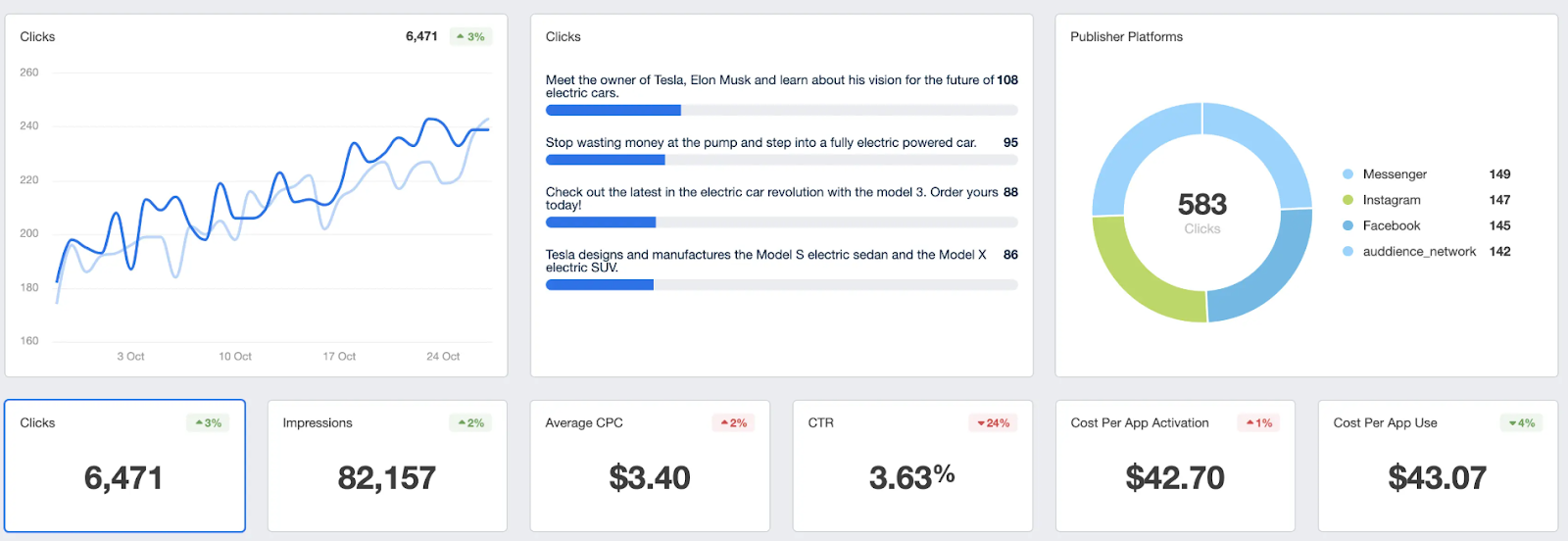
While all clicks indicate some level of interest, link clicks are the ones that truly matter for driving results. By prioritizing link clicks in your reports, you can focus on the actions that directly impact your campaign’s success.
10. CTR (Click-Through Rate): How Engaging Are Your Ads?
Click-through rate (CTR) is a key metric that shows how often people click on your ad compared to how many times it’s been seen (impressions). It’s a simple way to measure how engaging your ad is for your audience.
How to Improve CTR
- Better Headlines: Use clear and catchy headlines that instantly grab attention.
- Eye-Catching Visuals: Choose images or videos that stand out in the feed.
- Compelling Call-to-Action (CTA): Encourage users to click with action-oriented phrases like “Shop Now” or “Learn More.”
- Audience Targeting: Ensure your ad is reaching the right people by refining your audience settings.
Role of Third-Party Tools: EasyInsights
With third-party cookies disappearing and stricter data privacy regulations in place, advertisers face growing challenges in tracking users and optimizing campaigns effectively. The result? Less reliable data and more difficulty in lowering customer acquisition costs (CAC).
To continue driving conversions and performance, brands need to shift focus to first-party data, the information you collect directly from your users. Clean, enriched first-party data fuels better targeting, smarter optimization, and improved ROI.
EasyInsights plays a crucial role in this shift. It helps brands collect and activate high-quality, privacy-compliant first-party data, sending valuable insights like user behavior and CRM signals directly into ad platforms.
Conclusion
To run effective Facebook ad campaigns in 2025, tracking the right metrics is just the start. With signal loss and data limitations on the rise, data quality matters more than ever.
EasyInsights enables you to go beyond basic reporting. By enriching your campaigns with high-intent, first-party signals and creating precise, conversion-focused audiences, it empowers smarter, data-driven decision-making. Don’t just monitor your Facebook ads—optimize them for the future.
Book a demo with EasyInsights today and elevate your Facebook ads Metrics



